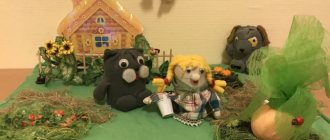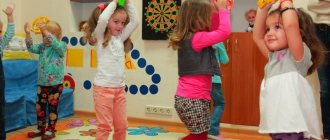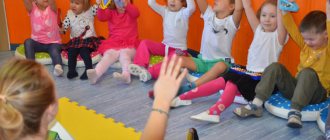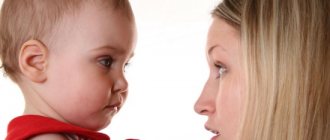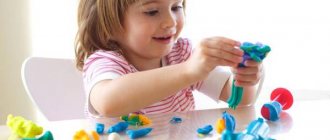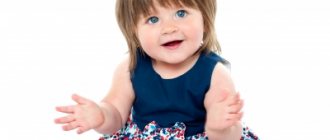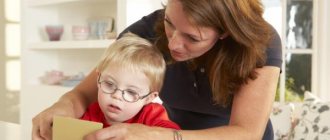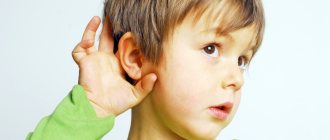Goals and objectives
Since speech therapy rhythms promote the development of general motor skills and speech, by developing motor activity, logorhythms for children help overcome speech barriers. There are correctional, educational, educational tasks.
Corrective tasks include solving the main problem - speech pathologies in preschool children. Educational tasks introduce children to the concepts of rhythm, register, and tempo. Educational tasks form in preschoolers the ability to move correctly to musical accompaniment and to be critical of their movements and speech.
Pedagogical principles
Logorhythmic work carried out within the preschool educational institution is based on a number of pedagogical principles:
- The anticipatory approach helps to identify preschoolers with organic and functional developmental defects. Such children need remedial education.
- Developmental education implies the harmonious development of the baby.
- Systematicity is based on the postulates of regularity and continuity of the correction process, which is impossible without timely and correct planning.
- The multifunctional approach is based on the simultaneous solution of a group of correctional tasks within one lesson.
- The etiopathogenetic principle takes into account the characteristics of speech deviation. When constructing logorhythmic classes, a differentiated approach is used.
- The gradual complication of the material allows for a transition from simple tasks to more complex ones. Raising to a new level is possible after consolidating the skills being developed.
- The effectiveness of visualization is explained by the presence of a close relationship between all body systems that analyze incoming information using available means. Due to this, preschoolers replenish the base of motor, visual and auditory images.
- Accessibility implies the importance of presenting material taking into account the characteristics of speech defects, physiological and age parameters of the child.
- The activity and consciousness demonstrated by children should find a positive response from the teacher, who understands the importance of activating cognitive processes in preschoolers.
- Success is based on the timeliness and quality of completing tasks given taking into account the capabilities of a particular child.
The training program is not an unshakable guideline that requires strict implementation. Responsibility for changing a certain part of the lesson rests with the teacher, who has an idea of the children’s abilities, their speech characteristics, etc. In some cases, it is advisable to introduce exercises from the cycle of articulatory gymnastics, while in other circumstances it is advisable to focus on pronouncing pure phrases. The song repertoire can be expanded by including children’s favorite songs, and the speech part can be supplemented with familiar poetic lines. A similar approach can be applied to game format materials.
Logorhythmic activities may extend beyond the established time frame. Fatigue, emotional overexcitation and apathy demonstrated by children are the primary reasons for reducing activities.
Music permeates the entire logorhythmic course. Musical accompaniment acts as dosed emotional training, which has a beneficial effect on both the physiological and psychological state of preschool children. It is important to understand that logorhythmic training programs for children of different age groups cannot be identical. The implementation of different schemes is explained by the developmental characteristics of preschool children at different periods of life.
Role and significance
To answer the question of what logorhythmics is, you need to evaluate the role of the method in the speech development of children. It performs a very important task for the teacher - it distracts them from the main problem with speech and allows them to solve it with the help of a logarithmic game. The child is open to communication during classes and can express himself creatively. Fun logorhythmics as a means of speech development for preschoolers has a positive effect on the health of children, their cardiovascular, respiratory, and speech motor systems.
Main directions of development of preschool children
Musical and speech activities carried out by children have a beneficial effect on the development of motor, sensory and intellectual functions. The last group included the ability to navigate in space, attention, perception, memory, thinking, imagination. In addition, there is the emergence and improvement of traits inherent in a harmoniously developed personality. In this case we are talking about kindness, manifestations of friendship, a tendency to self-criticism, etc. Positive changes are recorded in gaming activity and the emotional-volitional sphere. The basis for articulatory movements is also laid and facial muscles develop.
What kids can't do without logorhythmics?
Speech is a rather complex process. It involves different mechanisms: breathing, the work of the oral cavity, and the nervous system. The failure of one component causes problems in the entire speech process.
Logorhythmics classes are most needed for children with complex speech disorders. For example, children with a history of aphasia. Aphasia is a violation of already formed speech. With this disease, the perception of speech itself is also impaired. The task of the teacher in this case is to teach the preschooler to recognize speech addressed to him and to respond to it.
Classes are important for children with speech underdevelopment (OND and FFND), in which phonetics and the semantic side of speech suffer. Children with this disease get tired quickly and have difficulty learning material. With the help of logorhythmics, teachers help children overcome psychological barriers and adapt socially.
Speech therapy rhythms have a positive effect on children with stuttering and dysarthria - exercises, including breathing ones, create the necessary psychological mood and motivation.
Logorhythmic work throughout the day
The best results in improving pronunciation among preschoolers are observed provided that every preschool teacher makes an effort. The period of a child’s stay in kindergarten is replete with opportunities to include logarithmics in the established daily routine:
- Onomatopoeia and chants can become an integral part of morning exercises.
- Speech games are recommended before eating.
- Pure sayings, sentences and nursery rhymes can add a touch of liveliness to many routine processes, be it preparing for classes, washing or getting ready for a walk.
- It is advisable to alternate dynamic breaks between classes with logorhythmic pauses organized directly during classes.
- While walking on the street or within the walls of a kindergarten, you can involve preschoolers in low-mobility games or outdoor games accompanied by singing.
- You can also perform invigorating gymnastics, diversifying it with onomatopoeia.
- Appropriate speech material can be used at the stage of physical education classes of a theatrical nature.
- If possible, it is advisable to spend time organizing logorhythmic leisure activities.
Types of tasks in logorhythmics
Logorhythmics exercises include various movements, words, songs, and sounds. Combining this results in useful, interesting tasks. Classic types of speech therapy rhythm classes consist of walking, marching, breathing, and dancing exercises.
Walking is a mandatory exercise in every lesson. Rhythmic movements with the pronunciation of words help cope with speech development anomalies in preschoolers. The teacher needs to regularly complicate it: children must learn to march in a circle, in pairs, in threes, and learn a counter step. Walking teaches kids to navigate in space and develops correct posture. Performed to musical accompaniment.
Exercises to strengthen muscle tone help preschoolers cope with their movements and teach them to control muscle tone.
Logorhythmic exercises for the breathing apparatus also strengthen the cardiovascular system. Completing these tasks helps strengthen diaphragmatic breathing and trains the duration of inhalation and exhalation.
Voice development tasks involve pronouncing vowels and consonants while exhaling. Thus, children develop the strength and expressiveness of their voice.
Dance elements in the tasks allow you to develop motor skills and feel the beats. The movements are selected from classical and folk dance, where the baby’s arms and legs can be used.
A variety of speech tasks can be accompanied by music, then the baby must learn to pronounce lines in accordance with the musical beat. This trains memory well and develops expressiveness of speech.
Puzzles
Riddles are motivating when working with little ones, as they allow them to be as interested as possible and motivated to complete the task. It is better to choose riddles with a saying. So, based on the content and rhyme, the baby immediately understands what is being said.
Poems
Using poems, you can create a task with the addition of dance elements. During the performance, children pronounce what they show with their movements. After this, you can talk with the children about the content of the poem. This also includes logarithmic songs.
Short stories
By playing out small stories (fairy tales), children get ready to perform logorhythmic exercises.
Group of visual techniques
The teacher should prepare in advance for conducting classes, select pictures, videos with exercises, as well as toys, on behalf of which the procedure for completing tasks will be explained.
Practical techniques
Similar techniques are used to summarize the results of speech therapy classes. Such techniques include drawings, crafts, and projects. Projects can be completed at home, together with parents of preschoolers.
Gaming techniques
Almost all tasks in logorhythmics are based on the game. Where complex interaction is not provided, you can use games for the little ones that will help them get ready for work.
How to personalize tasks
In order for a preschooler to accurately remember material based on speech therapy rhythms, he must hear, see, and move during classes. By combining several techniques you can get attention from the most restless children.
Logorhythmics in complex therapy of stuttering in adults
Logorhythmics in the complex treatment of stuttering in adults helps overcome speech defects by developing the necessary qualities of general and speech motor skills.
Movement as a result of the influence of mechanical energy on the human body has been used as a preventive and therapeutic agent since ancient times, even during the birth of medicine. Treatment through movement involves the use of all types and forms of movement as a healing factor.
Modern Bulgarian scientists L. Bonev, P. Slynchev, St. Banks propose the term “kinesitherapy” to refer to this type of therapy.
Therapeutic rhythm is part of kinesitherapy. Its task is to develop a sense of rhythm using a system of physical exercises accompanied by music and use it for therapeutic and correctional purposes.
An integral part of therapeutic rhythm is speech therapy rhythm .
For speech therapy rhythms, research is important that provides knowledge about the connection and dependence of general and speech motor skills. Research on the physiology of movements and physiology of activity by N.A. Bernstein showed a hierarchical level system of regulation of motor functions, including speech. N.A. Bernstein attributed speech to the highest level of organization of movements - the cortical speech motor level of symbolic coordination and psychological organization of movements. N.A. Bernstein developed and put forward a theory of level organization of movements, including subcortical and cortical levels:
A - level of paleokinetic regulation, also known as the rubrospinal level of the central nervous system; provides unconscious regulation of body muscle tone with the help of proprioception, static endurance and coordination (rolling balls with the palm of the hand, grasping an object, adopting and holding a pose, fanning).
B - level of synergy and stamps, also known as thalamopallidal level; provides correction, internal coordination of the integral movement, coordination of its component parts, expressive movements, facial expressions, pantomime, plasticity (dressing, ability to fight).
C - level of the spatial field, also known as pyramidal-striate; ensures coordination of the motor act with external space with the leading role of visual afferentation, movements of a target nature, having a beginning and an end. Level C is divided into two sublevels:
C{ - striatal, belonging to the extrapyramidal system, the lower sublevel of the spatial field; assesses the direction of movement and doses the force along the movement (lacing, combing, flipping, tracking a moving finger, tracing a figure on paper).
C2 - pyramidal, belonging to the group of cortical levels, the upper sublevel of the spatial field, which is a complex afferentation system of the visual-spatial field; provides maximum target accuracy (rolling balls into holes, threading a needle, drawing a circle).
D - level of action, also known as parieto-premotor, cortical. The leading afferent system is the idea of an object. Afferentation is based on the semantic side of action with an object. The spatial field acquires new topological qualitative categories (top, bottom, between, above, before, then). The semantic logic of the action often does not correspond to the logic of geometric space (opening by unscrewing). The contingent of movements is self-service in a broad sense, all subject, labor and production activities, sports games. Awareness of the right and left sides of the body.
E - the highest cortical level of symbolic coordination and psychological organization of movements; understands someone else’s and one’s own speech, the content of the problem being solved, and expresses one’s thoughts in writing and orally; musical, choreographic performance (oral speech, written expression of thoughts, improvisation of movements). Actions at this level are based on imaginative thinking.
Soviet psychologists M. O. Gurevich, A. A. Leontyev, A. R. Luria pointed out the connection between speech and expressive movements, motor and speech analyzers, and the connection between the form of pronunciation and the nature of movements.
Research by L. A. Kvint and M. I. Dotsenko indicates positive correlations of general mental development with the development of voluntary facial motor skills. Similar connections in stuttering were pointed out by L.N. Murakhovskaya and V.M. Aristov.
Particularly important for logorhythmic education are data on the correlation between the degree of development of fine motor skills of the hand and the level of speech development in children.
Thus, the Soviet physiologist M. M. Koltsova believes that
“There is every reason to consider the hand as an organ of speech - the same as the articulatory apparatus. From this point of view, the projection of the hand is another speech area of the brain.”
From the history of musical education
At the beginning of the 20th century. In many European countries, the system of rhythmic education has become widespread. It became known as the “method of rhythmic gymnastics.” Its creator was the Swiss teacher and musician Emile Jacques-Dalcroze (1865-1950). E. Jacques-Dalcroze taught at the Geneva Conservatory. He was struck by the irregularity of the students. Dalcroze believed that a musician needed not only a good ear, but also a good rhythm. He decided to separate musical rhythmics into a separate branch of music pedagogy and “to cultivate the rhythmic feeling in itself.” Dalcroze made music his traffic controller.
What is the essence of the method of E. Jacques-Dalcroze? Using a combination of rhythm, music and movement, he solved the problem of “cultivating rhythm with the help of rhythm”
The Jacques-Dalcroze system was further developed in the works of his students and followers. Much credit for this belongs to N. G. Alexandrova and V. A. Griner. N. G. Alexandrova emphasized the importance of rhythmic education in school, which should be conducted on the basis of a close combination of rhythm and music (based on the Jacques-Dalcroze method).
On the initiative of N. G. Alexandrova, the Moscow Association of Rhythmists is being organized in Moscow at the State Academy of Artistic Sciences (GAKhN), which has developed a program of rhythm classes for music educational institutions (schools, technical schools, conservatories), formulated methodological instructions for the program and systematized methodological and musical notation. material. Russian rhythmists from Moscow and Leningrad in the 1920s developed a method of musical and rhythmic education in relation to the requirements of our time.
As N. G. Alexandrova wrote, the main principle of the Moscow school is to free Dalcroze’s rhythm from that touch of extreme aristocratic intellectualism, that difficulty and aspiration for virtuosity, which in the West make this system the property of a narrow circle of the few, especially gifted.
Rhythm according to the Jacques-Dalcroze system, based on the principle of accessibility, is one of the means of combating arrhythmia, which has a destructive effect on the psychophysical and social life of a person.
In our country in the 30-40s, the system of musical and rhythmic education was developed by N. G. Aleksandrova V. A. Griner, N. P. Zbrueva, E. V. Konorova, M. A. Rumer, E. P. Shepulin. V. Slepovich et al.
N. G. Alexandrova in her early works (30s) emphasized the importance of the differentiated use of rhythm depending on the age of people and their state of health.
The pioneer of introducing therapeutic rhythms into the system of treating neurotic patients is prof. V. A. Gilyarovsky. Under his leadership in 1926 at the neuropsychiatric hospital named after. Solovyov (former Donskaya hospital) a special system of therapeutic rhythms was created for children and adults. In practice, this system was implemented by rhythmist V. A. Griner, who, like N. G. Alexandrova, graduated from the Jacques-Dalcroze Institute of Music and Rhythm in Hellerau. In her work with the mentally ill, she used such a positive factor of rhythm as its collective principle.
Therapeutic rhythms were also used in speech therapy institutions in the 1930s.
In the system of rhythmic influence on people with speech pathology, the leading place is occupied by the word. In this regard, a special direction of influence in rehabilitation methods is being formed - speech therapy rhythm. Initially, speech therapy rhythms were used in work with stuttering preschoolers on the initiative of V. A. Gilyarovsky and N. A. Vlasova. In their article “Speech therapy rhythms” (1936), V. A. Griner and Yu. A. Florenskaya first raised the question of developing special speech therapy rhythms for classes with stutterers in order to improve their speech.
V. A. Griner has developed practical material for adults who stutter. She considered it necessary to become familiar with the characteristic features of the patient’s motor skills upon admission and upon discharge, paying special attention to the state of muscle tone, gait, hand movements, tempo of movements, stability of attention and memory, forming, depending on this, the approach to the patient and the requirements for him. V. A. Griner emphasized that the fundamental difference between speech therapy rhythm and the method of rhythmic education is that in the exercises special attention is paid to the word.
V.I. Dresvyannikov, studying the characteristics of motor skills of stuttering schoolchildren in grades VI-VIII, identified a relationship between the development of motor skills and expressive speech, between the degree of stuttering and the degree of motor impairment, and proposed a system of physical exercises to eliminate stuttering in schoolchildren aged 12-15 years. V.I. Dresvyannikov emphasizes the great potential of speech therapy rhythms in re-educating the speech of people who stutter, provided that classes are conducted in a qualified manner.
The method of musical and rhythmic education of E. Jacques-Dalcroze began to be used abroad for therapeutic and pedagogical purposes. In the 60s of the XX century. Polish logorhythmist Aurelia Rosenthal made an attempt to introduce elements of rhythmoplasty into speech therapy work. The therapeutic program she created was aimed at the rehabilitation of people who stutter.
A. Rosenthal’s program includes Dalcroze rhythmic exercises, which, on the one hand, prevent the occurrence of arrhythmia in the process of speech development of a stutterer, and when it occurs, they rationally level it out; on the other hand, rhythmic exercises satisfy the living organism’s need for movement, and a positive emotional background promotes relieving tension.
A new method of speech correction - logorhythmics - is based on a combination of words and musical rhythm and includes both programmed and improvised accompaniment of rhythmic body movements in accordance with the music.
Today, the main task of speech therapy rhythm in the correction of stuttering is to help overcome the speech defect of patients by developing the necessary qualities of general and speech motor skills.
Speech therapy rhythm in the correction of stuttering in adults involves solving the following problems:
- Formation and development of muscle relaxation skills.
- Formation of skills of costo-obdominal type of breathing and singing exhalation.
- Development of voice function.
- Development of the ability to coordinate speech with movement. Development of smoothness and unity of voice.
- Development of the prosodic side of speech.
- Development of a sense of tempo and rhythm, plasticity, rhythm, coordination of movements.
- Stimulating non-verbal communication skills.
The formation and development of muscle relaxation skills in adults who stutter is realized through:
- Exercises with alternating tension and relaxation.
- Exercises to develop correct posture.
- Exercises to develop balance.
- Muscle relaxation exercise.
The formation of skills of the costo-obdominal type of breathing and singing exhalation is carried out in exercises aimed at developing diaphragmatic breathing, and with the help of voice exercises based on the costo-obdominal type of breathing and half-yawn based on vowel sounds.
The development of voice function in logorhythmics classes is carried out based on:
- Chanting vowel sounds in the lower register with increasing speech exhalation.
- Chanting vowel sounds with modulation (“sound track”).
- Singing a hissing sound with resistive hand movements to increase the strength of the voice.
- Chanting combinations of vowel sounds in the lower register to improve oral praxis.
- Exercises aimed at developing vocal resonance.
- Music with emotional and motor involvement.
The development of coordination of speech with movement, which is aimed at rhythmizing speech as a whole, is carried out on the basis of logorhythmic exercises using the sound of a metronome. These can be various poems, passages, tongue twisters, read by stutterers on a syllable-by-syllable rhythm, both in chorus and line by line in a chain: (“Margarita collected daisies on the mountain...”, “The Greek was driving across the river...”, “My sister Marina has cheeks like tangerines. .." and etc.)
The following requirements are presented for their implementation :
- Exercises are performed using a metronome.
- The syllable/word-by-word rhythm of speech with continuous vocalization is activated.
- Various gestures and gross motor movements are used.
- Poetic forms, tongue twisters, proverbs and sayings are used.
The speech of people who stutter is extremely monotonous and has little intonation coloration. In speech therapist classes on logorhythmics, the development of the prosodic side of speech .
The following techniques are used when working on prosody:
- Pronouncing combinations of vowel sounds with a given intonation (AOUI with anger, for example, etc.)
- Pronunciation of individual words, phrases with a certain intonation coloring (“Here, name, take it!”)
- Pronouncing tongue twisters with questioning/affirmative intonation for a specific word.
Tongue twisters can be as follows:
- A rat in Rome gnawed rice.
- The crow missed the little crow.
- The water truck was carrying water from the water supply system.
- Lilliputian was catching roach on a raft.
- Near the bell stake.
Developing a sense of tempo and rhythm.
The development of plasticity, rhythm, and coordination of movements in the system of logorhythmics classes occupies an important place and can be carried out using the following techniques:
- Collective dance (sirtake, letka-enka).
- Exercises on non-verbal communication, group interaction.
- Free dance movements based on classical and modern dance music with variable tempo: from slow to fast and in reverse order.
- Exercises for reciprocal coordination (complex forms of coordination of movements).
- Exercises for combinations of voluntary movements of the patient’s general motor skills and speech using word-by-word rhythm.
Used Books:
- Selected works on speech therapy/Yu.A. Florenskaya; compiled by E.E. Shchevtsova.-M.: AST; Astrel, KHRANITEL, 2007.-223 p.
- Stuttering/I.A.Sikorsky.-M.AST.Astrel: Transitbook, 2006.-191p.
- Fundamentals of neuropsychology: textbook. for university students / T.G. Vizel, -M.:AST: Transitbook, 2006, -384 p.
- Speech therapy rhythms for classes with stuttering adolescents and adults / E.V. Oganesyan, M. - 1998.
- Stuttering/Shklovsky V.M. M. - 1994.
- G.A. Volkova, Speech therapy rhythmics, M.: Education, 1985, - 446 p.
Shchepina L.N., speech therapist of the highest category
- Speech therapy work to correct stuttering in adults and adolescents
- Methodological recommendations for teachers “Logorhythmics as a means of correcting speech and non-speech disorders”
- Logorhythmics as a form of speech correction for children of primary preschool age with delayed speech development
- Gaming technologies in the correction of stuttering in children of preschool and primary school age
- Removing muscle tension in adults who stutter during correctional work
( 1 liked, average score: 5.00 out of 5)
Loading...
What do such activities give to children?
Logorhythmics allows you to overcome speech pathologies with the help of aesthetic education, correction of motor skills, while combining music and words. Logorhythmics forms and develops:
- auditory attention;
- musical, timbre, dynamic hearing;
- movement in space;
- fine, gross motor skills, facial expressions;
- kinesthetic sensations;
- the skill of correctly using sounds in different forms;
- coordination of the type of music with movements, understanding of rhythm.
The goal and objectives of logorhythmics combine work on the correction of speech disorders, motor skills and psychological methods of development. The method is aimed at results at an age when it is impossible to carry out complex correctional classes. Positive influence allows preschoolers to better master speech, motor skills, understand the task, and express themselves creatively.
Features of logorhythmic exercises
Logorhythmics involves performing a variety of exercises. In addition to speech varieties, walking can be involved, which involves regular changes in direction. Exercises that form a sense of musical rhythm are included in a separate group. Singing and performing actions aimed at improving fine motor skills have proven themselves to be excellent. Some of the exercises are responsible for the development of voice, articulation or breathing, while others help to activate muscle tone and increase attention.
Musical accompaniment makes the exercise process easier. The aesthetic function of emotionally coloring activities is also assigned to it. Games that seem simple at first glance not only entertain the baby, but also help improve motor skills and develop the speech apparatus. Examples of such games are given in specialized printed publications. In the absence of the latter, all the necessary information can be found on the Internet.
